IN THIS ISSUE
NEWS: McConnell starting to have a little fun
BRACK: More civics education is a good thing
PLUFF MUD KIDS: PAW (parents are watching) social media
IN THE SPOTLIGHT: catherine e. lafond, p.a.
GOOD NEWS: This picture says a million things
FEEDBACK: Send us your letters
REVIEW: Station Eleven
CALENDAR: Lots of fun stuff ahead
MYSTERY PHOTO: What’s missing?
S.C. ENCYCLOPEDIA: John LaFayette Girardeau
NEWS
McConnell starting to have a little fun
Glenn McConnell is starting to enjoy being president of the College of Charleston.
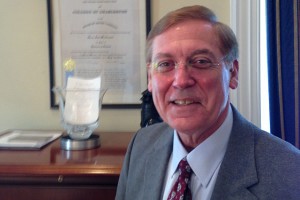
College of Charleston President Glenn McConnell says he’s the first president in 178 years to be a graduate of the college. His diploma is in the background. (Photo by Andy Brack).
“I couldn’t have given you than answer in July,” says the longtime former West Ashley senator who grudgingly became lieutenant governor in 2012 before taking over the college.
Within 30 minutes of beginning as new president last year, members of the basketball team told him they didn’t want to play for the coach. That kerfuffle took the majority of his time for almost two months before it got straightened out, McConnell said in a Friday interview.
“There are so many moving parts [to this job] that it’s hard to have the time to move some big things forward,” he said. “You get bogged down in the micro before you can get to the macro.”
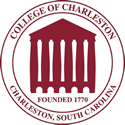 But in less than eight months, McConnell has been at the helm for some big wins.
But in less than eight months, McConnell has been at the helm for some big wins.
The biggest may be the fall approval by the state Commission on Higher Education to operate a research university within the College of Charleston. Usually a university engulfs a college. But McConnell said because former president Harry Lightsey had the foresight to set up a university component under the college, the CHE approval now allows an unused structure to mature as a research university. In turn, that will allow it to boost academics, grant more doctoral degrees and access federal research grants.
“Using the institution that he created, we threaded the eye of the needle,” McConnell said. “We set up a research university within the College of Charleston.”
With that designation, the college can attract new donors who want to help to establish advanced courses “from a competitive economic standpoint that this region needs to have for development and employment.”
By pumping up academic muscle in areas like computer science, information management and supply chain logistics, the college will be able to provide companies with the 21st century local talent they need here, he said. At the same time because the college is the top dog over the new university structure, “we preserve the best of who we are,” McConnell said. “It also sets the college up where we shape our future and don’t get shaped by it.”
In the weeks ahead, McConnell will be on the road meeting with donors to try to raise more money for the college as it nears completion of a $125 million comprehensive campaign. So far, it has raised more than $114 million, the president said.
Half of the money will go to scholarships, which McConnell said he planned to use to make the college more accessible, affordable and inclusive.
“If you make it affordable and accessible, then we pick up students from lower socioeconomic levels who could not be here,” he said. “I want the College of Charleston to be a place so if you’re from Branchville or Boston, you can come here.
“Scholarships are life-changing. They can completely change the trajectory of a person’s life.”
McConnell envisioned a future campus that looked more like the state of South Carolina, a third of which is comprised of non-white minorities. The college today has a 15 percent minority population, but only about 6 percent of the student body is African American.
Applications from black students are up about 15 percent this year, a trend McConnell said he wanted to see continue. In fact, he said the college is planning to launch a pilot program in seven area counties to automatically admit anyone who graduates in the top 10 percent of his or her high school class.
Running a college is a lot different from the partisan environment of running the state Senate, which McConnell did for years. It’s an executive role, rather than a legislative one.
But some of the life lessons he’s had — running a small business, being a lawyer and having to listen to all sides of issues to try to get compromise — are paying off in Randolph Hall, where the president’s office is located.
“I feel like the school is on the move and we’re making progress.”
BRACK
More civics education is a good thing
My 11-year-old daughter fretted last week over which president’s name she would draw from a hat at school for a history project. She was emphatic that she didn’t want somebody “boring” like Ulysses S. Grant, not a terribly popular name in our household.
![]() She wanted John F. Kennedy, probably because she has a youth-reader biography of him. I suggested Harry Truman might be better, to which she said, “Oh, the guy who dropped the atomic bomb.” She selected neither, but seemed satisfied with Georgia’s Jimmy Carter of whom she knows little. He has accomplished a lot since his presidency, I told her, and she should include that in the research.
She wanted John F. Kennedy, probably because she has a youth-reader biography of him. I suggested Harry Truman might be better, to which she said, “Oh, the guy who dropped the atomic bomb.” She selected neither, but seemed satisfied with Georgia’s Jimmy Carter of whom she knows little. He has accomplished a lot since his presidency, I told her, and she should include that in the research.
The point of the story is that she is excited to be learning about presidents and, in turn, American government. But lots of students throughout the state and nation have little understanding or connection with how America works because we haven’t emphasized old-fashioned civics.
Now comes a new initiative to stress civics education in state schools and it’s something state lawmakers should approve.
“It is so important that all of our students graduate from high school with a basic knowledge of how and why our government works,” former Gov. Dick Riley told Statehouse Report last week. “This will help them go on to lead more productive lives in college and careers and in life, itself. This very basic knowledge of civics is critical to being a good and effective citizen of our great democracy.”
Riley, a former U.S. secretary of education, is among three former governors pushing the civics education initiative. Also on board are former governors David Beasley and Jim Hodges. So was the late Jim Edwards, who passed away in December. The effort now has been named in his honor.
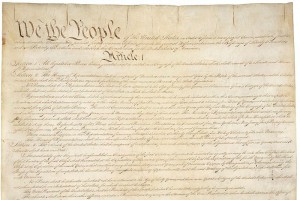 The James B. Edwards Civics Education Initiative calls for high school students to take a 100-question U.S. Citizenship Civics Test as part of an existing half-year course in government. The proposal doesn’t mandate passage of the test as a requirement for graduation (although it should), but students who get a passing score of 60 or better will receive an achievement certificate. Results will be reported to the state for assessment. No cost is envisioned as the test and all study materials are online for free. (More: http://civicsquiz.com/).
The James B. Edwards Civics Education Initiative calls for high school students to take a 100-question U.S. Citizenship Civics Test as part of an existing half-year course in government. The proposal doesn’t mandate passage of the test as a requirement for graduation (although it should), but students who get a passing score of 60 or better will receive an achievement certificate. Results will be reported to the state for assessment. No cost is envisioned as the test and all study materials are online for free. (More: http://civicsquiz.com/).
See if you know the answers these CivicsQuiz sample questions, most of which are taken from the exam taken by people who want to become naturalized U.S. citizens:
- What are two rights of all American citizens?
a. Right to vote; right to a job
b. Right to succeed; right to pursue happiness
c. Right to free speech; right to health care
d. Right to bear arms; right to free speech - What is one thing Benjamin Franklin is famous for?
a. Invented the Cotton Gin
b. First Postmaster General of the United States
c. Third President of the United States
d. Discovered gravity - Which constitutional amendment related to voting rights for women?
a. 1st
b. 27th
c. 19th
d. 2nd
A broad, bipartisan group of House and Senate leaders this week backed the initiative.
“Understanding basic civics is fundamental to becoming and engaged and responsible citizen,” said bill co-sponsor James Smith, a Democratic state representative from Columbia. “If we ask immigrants to know these facts about our country to become good citizens, we should make sure our own citizens understand these same principles.”
According to proponents of the measure, 92 percent of immigrants seeking citizenship pass the test on the first try. Want to guess how many high school students in Oklahoma and Arizona pass the test according to studies? 4 percent.
High school graduates should have a better, basic understanding of American civics and history. This is something we can fix. So let’s do it — if not for individual students, then for the state and country.
(Answers: 1d; 2b; 3c.)
PLUFF MUD KIDS
PAW (parents are watching) social media
By Leigh Sabine | Our children are not ours to keep. They are just on loan to us. You hear people say this from time to time and I’m beginning to see the truth in the saying as my boys leap from one milestone to the next.
42 percent of teens say they can text blindfolded.
– Tech Savvy Parenting – Brian Housman
 As well-meaning, intentional parents, we try our level best to raise boys to upstanding men, girls to strong young women. At a certain point in our child’s maturity (and it’s important to note that the arrival of this point varies from child to child), our child is ready to begin to step out of our orbit — to take what we have carefully taught them as right and true and apply it to the real world. Nowadays, that child will be walking away from us with a cell phone gripped tightly in their hand.
As well-meaning, intentional parents, we try our level best to raise boys to upstanding men, girls to strong young women. At a certain point in our child’s maturity (and it’s important to note that the arrival of this point varies from child to child), our child is ready to begin to step out of our orbit — to take what we have carefully taught them as right and true and apply it to the real world. Nowadays, that child will be walking away from us with a cell phone gripped tightly in their hand.
Enter the multifaceted, ever changing world of technology. We’ve come a long way since that first email was sent in 1971. Every imaginable tool of our new tech world fits nicely into the compact cell phone that our children now cradle in the palm of their hand. Are you really ready to hand them the world? Can your child handle this fully-loaded Lamborghini before they’ve even earned their driver’s permit?
Average number of texts sent by a teen each month: 3,339.
– Tech Savvy Parenting – Brian Housman
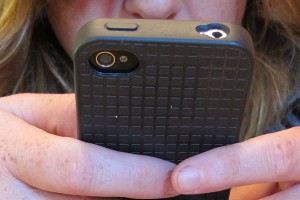 I recently attended a community talk on social media and it’s affects on our children. It was both enlightening and frightening. A panel of experts that included a police officer, a popular blogger, a tech guru, and a child counselor, had a firm grasp on all aspects of our digital world and the possible pitfalls that arise from the wrong click of a button, a picture sent that lands in the hands of a stranger, the danger wrapped in a seemingly innocent hashtag.
I recently attended a community talk on social media and it’s affects on our children. It was both enlightening and frightening. A panel of experts that included a police officer, a popular blogger, a tech guru, and a child counselor, had a firm grasp on all aspects of our digital world and the possible pitfalls that arise from the wrong click of a button, a picture sent that lands in the hands of a stranger, the danger wrapped in a seemingly innocent hashtag.
There are more than 7.5 million underage (13 and younger) children in America on Facebook. Only 53% of parents are aware that Facebook has a minimum age requirement.
– Tech Savvy Parenting – Brian Housman
For what it’s worth, here are a few things I have learned through the aforementioned community session and through further research about our children and social media. It seems too valuable not to share…
Know your child’s passwords and consider that a periodic check of your child’s phone use could be part of the contract you have with your child regarding their phone/computer. The master bedroom is a perfect spot for a family docking station. This helps to instill unplugged family time and protects a child’s normal sleep patterns and nighttime routines.
Children model parents’ behavior. Never look at your phone while you’re talking to your child or your child is talking to you. Never bring your phone to the dinner table. Put your phone away while driving your car — children in the back seat can’t differentiate between scrolling through your phone for email, text or directions and none of it matters while the car is in motion.
Keepin’ it movin’. Popular social media sites are ever changing. Just when you think you have a handle on an app, a new one comes along. Some of the most popular are Tumblr, Vine, Twitter, kik messenger, Instagram, Omegle, Whisper, Snapchat and Tinder. Take the time to check these apps out and quiz a teen for inside intel on how the apps work. For example, what’s a “power swipe”? Ask the right teen and they’ll tell you. Choose a few apps to try firsthand to better understand the positive and negative aspects that could wind up on your child’s phone or computer.
Forearmed is forewarned. Read a book on the subject. Tech Savvy Parenting by Brian Housman is great. Some of my favorite websites for more information on the subject are commonsensemedia.org, empoweringparents.com and 360family.org.
Refer to the Children’s Online Privacy Protection Rule provided by the Federal Trade Commission that seeks to protect children under the age of 13. Check the link here.
On the lighter side, I’ll leave you with a bit more food for thought. HTH (hope this helps).
- Hilarious texts between a husband and wife — truly sums up a modern marriage.
- Time Magazine‘s 92 teen text terms
IN THE SPOTLIGHT
catherine e. lafond, p.a.
 Attorneys Catherine E. LaFond and Ashley Andrews and their competent team offer compassion and broad experience in helping clients with real estate closings, estate planning, and securing veterans’ benefits and other long-term care benefits. Located at 544 Savannah Highway near Folly Road, catherine e lafond, p.a., is convenient for appointments with helpful staff members who can help you and your family craft wills and trusts, weave comfortably through the maze of estate and elder law planning options, and close real estate loans for refinancing or purchases.To learn more, contact catherine e. lafond, p.a., at 843.762.3554.
Attorneys Catherine E. LaFond and Ashley Andrews and their competent team offer compassion and broad experience in helping clients with real estate closings, estate planning, and securing veterans’ benefits and other long-term care benefits. Located at 544 Savannah Highway near Folly Road, catherine e lafond, p.a., is convenient for appointments with helpful staff members who can help you and your family craft wills and trusts, weave comfortably through the maze of estate and elder law planning options, and close real estate loans for refinancing or purchases.To learn more, contact catherine e. lafond, p.a., at 843.762.3554.
- Visit online at LaFondLaw.com.
GOOD NEWS
This picture says a million things
Above is a photo of officials from MWV Specialty Chemicals & Community Development and Land Management presenting a check for more than $1 million to the Trident United Way. MWV is the first company in Lowcountry history to raise at least a million dollars for the charity.
Pictured (l-r): Becky Vaughan, MWV Specialty Chemicals; Joseph Johnston, MWV Community Development and Land Management; Steven Hill, MWV Specialty Chemicals; Eric Walmet, MWV Specialty Chemicals; Caroline Byrd, Trident United Way; Dan Gallagher, MWV Specialty Chemicals; Ken Seeger, MWV Community Development and Land Management; Christopher Kerrigan, Trident United Way; Ed Rose, MWV Specialty Chemicals; David Northrup, MWV Specialty Chemicals; Alaina Siefring, MWV Specialty Chemicals. Photo provided.
More good news:
![]() Into the S.C. Academy of Authors Hall of Fame. The South Carolina Academy of Authors will honor writers Dorothea Benton Frank of Sullivan’s Island, former College of Charleston professor Bret Lott and Mount Pleasant poet Marjory Heath Wentworth on April 11 at 6 p.m. at The Citadel’s Riverview Room in Charleston. More.
Into the S.C. Academy of Authors Hall of Fame. The South Carolina Academy of Authors will honor writers Dorothea Benton Frank of Sullivan’s Island, former College of Charleston professor Bret Lott and Mount Pleasant poet Marjory Heath Wentworth on April 11 at 6 p.m. at The Citadel’s Riverview Room in Charleston. More.
New park. The former Baker Hospital on the banks of the Ashley River will become a new peninsular park thanks to a donation of the 57-acre property facilitated by local and Atlanta-based real estate teams and local funding from two local families. “This new park is being made possible due to the generosity of the [Michael and Jenny] Messners and [Paul and Betsy] Shivericks and their partners. We also credit Magnolia/ARC Lender’s commitment to listening and responding to the greater community’s needs,” said Tom O’Rourke, executive director of the Charleston County Parks and Recreation Commission. More.
Chef wins. Hats off to Chef Vinson Petrillo of Charleston’s Zero George Street Hotel. He has been selected to represent the U.S. at Expo Milano 2015 in June, competing against 19 young chefs from across the globe for the title of S.Pellegrino Young Chef 2015. Not only did he become a father on Friday, but last week at Astor Center in New York City, he presented a winning dish of pressurized octopus, wagyu cheek agnilotti, “parsley”, chorizo, octopus ink emulsion to a panel of esteemed judges. More.
Center recognized. Summerville Medical Center and the Coastal Carolina Bariatric Center have earned national distinction as a comprehensive Bariatric Center of Excellence by the American College of Surgeons (ACS). A bariatric surgical center achieves accreditation following a rigorous review process during which it proves it can maintain certain physical and human resources and the highest standards of practice. “Not only have we been distinguished for our quality, but for the three years we have been in practice at Summerville Medical Center, our team has been recognized because of the experience patients have in our office and our hospital, as the best in patient satisfaction every year,” said Dr. Neil McDevitt, director of the Coastal Carolina Bariatric Services and a fellow of the American College of Surgeons.
FEEDBACK
Send us your letters
If you have an opinion on something we’ve offered or on a subject related to the Lowcountry, please send your letters of 150 words or less to: editor@charlestoncurrents.com.
- Our feedback policy.
REVIEW
Station Eleven
By Emily St. John Mandel
![]() This is the way the world ends, not with a bang but a sneeze.
This is the way the world ends, not with a bang but a sneeze.
Twenty years after a deadly virus killed 99.99 percent of the population, effectively ending life as we know it, a band of traveling musicians and actors performs Shakespeare by candlelight, bringing moments of beauty to weary survivors struggling to exist in civilization’s ruins. A charismatic psychopath calling himself “prophet” behaves as badly as you’d expect a self-proclaimed prophet in a post-apocalyptic landscape to behave. The best friend of a long-dead once-famous actor collects and displays useless artifacts from a forgotten time: smartphones, tablets, stiletto heels. And a comic book about a ruined world, written years before the collapse, connects them all.
Mandel deftly weaves these complex threads into a chilling tale that is by turns darkly comic, horrifically bleak, and achingly brilliant. A beautifully crafted post-apocalyptic survival story for grownups.
– Andria L. Amaral, Main Library, Charleston, S.C.
 Find this and similar titles from Charleston County Public Library. This item available as a book. To learn more or place a hold, visit www.ccpl.org or call 843-805-6930.
Find this and similar titles from Charleston County Public Library. This item available as a book. To learn more or place a hold, visit www.ccpl.org or call 843-805-6930.
CALENDAR
Lots of fun stuff ahead
FollyGras: Feb. 16-21, Folly Beach. The 8th annual celebration is Folly’s take on Mardi Gras and is comprised of a week full of activities, including a Fat Tuesday Block Party and a masquerade ball with the main party on Feb. 21. More.
(NEW) Black history lecture: 6 p.m., Feb. 18, Old Slave Mart Museum, 6 Chalmers St., Charleston. Green Pond author Jeff Grigg will talk about his book, The Combahee River Raid: Harriet Tubman & Lowcountry Liberation. Free.
(NEW) All-Stars marker: 2 p.m., Feb. 19, Harmon Field, corner of President and Fishburne streets, Charleston. A historical marker will be dedicated to recognize the Cannon Street Y All-Stars, the 1955 Little League baseball team that became a symbol of the civil rights movement. The marker will also honor Harmon Field, established in 1927.
Book launch: 5 p.m., Feb. 19, Blue Bicycle Books, 420 King Street, Charleston. Local writer Tom Turner will read and talk about his debut detective novel, “Palm Beach Nasty,” which was released last month. A native New Englander, Turner relocated to Charleston after falling in love with it. More.
(NEW) Radio fundraiser: 8 p.m. to midnight, Feb. 21, Royal American, 970 Morrison Drive, Charleston. It’s OHM Radio Night as organizers seek to finish raising money for the community’s first commercial-free radio station with music from the High Divers, Travelin Kine and Jordan Igoe. Tickets are $5.
Annual Women’s Conference: 8:30 a.m. to 3 p.m., Feb. 26, Towne and Country Inn, West Ashley. The Center for Women expects 150 people to attend the annual conference, which will have nine breakout sessions. Keynote speaker is Jade Simmons, a concert pianist and motivational speaker. More.
(NEW) DIY Festival: 1 p.m. to 4 p.m., Feb. 28, Main Library, 68 Calhoun St., Charleston. You can explore local do-it-yourself projects at interactive booths, listen to neat lectures and learn about new technologies like 3D printer at the festival. More info. http://www.ccpl.org
Mozart’s Requiem: 6 p.m. Feb. 28, St. Philip’s Church, 142 Church St., Charleston. Leading British choral conductor Edward Higgenbottom will lead the Charleston Symphony Orchestra Spiritual Ensemble in Mozart’s full Requiem to honor Le Chevalier de Saint-Georges, an early 18th century black composer and contemporary of Mozart. The performance is part of the local celebration of African-American History Month. Tickets: $35 for adults. More.
The Diary of Anne Frank: Through March 1, Dock Street Theatre, Charleston. Charleston Stage will offer stage performances of the remarkable story of Anne Frank. There’s an online education guide as well as talkback discussions and background information. More info about the play. Tickets range from $22.50 to $53.50.
Book sale: March 6 and 7, Mount Pleasant Regional Library, 1133 Mathis Ferry Road, Mount Pleasant. Charleston Friends of the Library will have its annual sale in Mount Pleasant with great bargains on good books and other media. The event opens at 9 a.m. on both days. More.
(NEW) Mullet Haul Trail Run: 8:30 a.m., March 7, Mullet Hall Equestrian Center, Johns Island. The 5th annual trail run features a 5- and 10-mile off-road run. Fees. Click here to learn more and register.
Bushels & Bids: 4:30 p.m. to 7:30 p.m., March 7, Charles Towne Montessori, 56 Leinbach Drive, West Ashley. The community’s oldest and only internationally-accredited Montessori school will have an oyster roast fundraiser with local oysters and live music by Castle Crossing. More.
U.S. Navy Band to perform: 6:30 p.m., March 9, Meyers Theater for the Performing Arts, 5109 W. Enterprise St., North Charleston. The city is only one of 32 this year to host the Navy’s concert band, which will present an array of marches, patriotic selections and more. Free. More.
Charleston Tells: March 13-14, Wragg Square, Charleston. The third annual Charleston Tells Storytelling Festival will bring together some of the best of national and international storytellers in one place over two days. Presented by the Charleston County Public Library, the event features nine acclaimed storytellers and others. Last year, more than 1,600 people enjoyed the event. Don’t miss it this year. Tickets are $40 with kids 12 and under for free. More.
(NEW) Lowcountry Cajun Festival: Noon to 6 p.m., March 29, James Island County Park, James Island. A full day of tunes, food and activities will ensue as the area celebrates all things Cajun. $15 for 13 and up. More.
Art on Paper: Through April 5, 2015. While the Gibbes Museum of Art is renovating its space through next year, its third annual Art on Paper exhibit will continue — just in a different location. This year, the exhibition of works on paper will come from six local galleries and be featured at The Vendue, Charleston’s art hotel at 26 Venue Range, Charleston. An opening reception is 5 p.m. to 8 p.m., Feb. 6, at the hotel
Fashion Flashback: Through May 10, 2015, 360 Meeting St., Charleston. The Charleston Museum will offer a new fashion exhibition, “Fashion Flashback, 1920s-1960s: Five Decades of Style that Changed America” in its Historic Textiles Gallery. A light-hearted look at 50 years of fashion, viewers will enjoy exploring clothing styles from the swinging 1920s to the hip 1960s. Learn more here.
Natural history exhibit: Through Aug. 10, 2015. “From Land to Sea: 35 Million Years of Whale Evolution” will be featured in The Charleston Museum’s lobby gallery with displays of whale fossils from millions of years ago. There’s limited availability for an overview by Natural History Curator Matthew Gibson on opening night. Learn more.
Bird walks: 8:30 a.m. to noon, every Wednesday and Saturday. This is the time of year that a great variety of migrating birds fly through the Lowcountry so what better time to take part in one of the regular early morning bird walks at Caw Caw Interpretive Center in Ravenel. Pre-registration is suggested. Cost is $5. Walks also are conducted on James Island and Folly Beach. Learn more online.
If you have an event to list on our calendar, please send it to editor@charlestoncurrents.com for consideration. The calendar is updated weekly on Mondays.
MYSTERY PHOTO
What’s missing?
 Go back and look at the photo at the top of the page. Hanahan photographer Chuck Boyd offers this retouched picture, which might make you scratch your head a bit. Could something be missing? If so, what? Send your answer to: editor@charlestoncurrents.com.
Go back and look at the photo at the top of the page. Hanahan photographer Chuck Boyd offers this retouched picture, which might make you scratch your head a bit. Could something be missing? If so, what? Send your answer to: editor@charlestoncurrents.com.
Lily Hunt of Charleston correctly identified the green humanoid mystery figure that perplexed readers for more than a week. She won a pair of tickets to Magnolia Plantation and Gardens.
Also correct were Ernest Hedler of Charleston and College of Charleston professor Hayden Smith, who wrote. “Gumby is on the side of J&W Grocery, at Pitt and Montagu, if I remember correctly.”
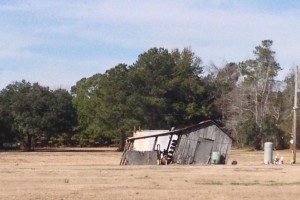 Chris Brooks of Mount Pleasant, who gets just about every photo mystery correct, struggled to remember the location of the Gumby image. But he got the location correct of the leaning barn, which is just south of McClellanville on U.S. Highway 17.
Chris Brooks of Mount Pleasant, who gets just about every photo mystery correct, struggled to remember the location of the Gumby image. But he got the location correct of the leaning barn, which is just south of McClellanville on U.S. Highway 17.
S.C. ENCYCLOPEDIA
John LaFayette Girardeau
John LaFayette Girardeau was born on November 14, 1825, on his family’s plantation on James Island, the son of John Bohun Girardeau and Claudia Herne Freer. He attended a school on the island taught by Rawlins Rivers and went to the James Island Presbyterian Church where his parents, grandparents, and numerous relatives were members.
Following the death of his mother, he went to the school of the German Friendly Society in Charleston. He entered the College of Charleston at age fourteen and graduated at eighteen. In 1845 he entered Columbia Theological Seminary where he studied under George Howe, Charles Colcock Jones, and Aaron Leland and came under the influence of James Henley Thornwell and Benjamin Morgan Palmer. After his graduation from Columbia in 1848, he served the Wappetaw Independent Presbyterian Church in Christ Church Parish and the Wilton Presbyterian Church at Adams Run on the lower Edisto River. Both of these congregations were composed of wealthy planters and numerous slaves. In 1849 he married Penelope Sarah Hamlin. The couple had ten children.
In 1853 Girardeau was called as pastor to the Anson Street Presbyterian Church, Charleston, a congregation organized for mission to slaves. A powerful preacher who was at home with the Gullah dialect, Girardeau attracted large numbers of African Americans to the congregation. To accommodate the growing crowds, a new church building, Zion Presbyterian, was built on the corner of Calhoun and Meeting Streets primarily with money from the Adger and Smyth families of Charleston. Zion was said to have the largest church sanctuary in the city. A small group of affluent whites belonged to the church, served as officers, and sat in the balcony while the large African American congregation utilized the main floor. Girardeau’s work was an experiment in paternalism that drew on the theological and social thought of James H. Thornwell.
During the Civil War, Girardeau served as a chaplain in the Confederate army. He returned to Charleston in 1865 as an advocate for the old order, insisting that southerners must “cling to our identity as a people.” He was ousted from the Zion pulpit by northern missionaries, but he later returned at the request of his former black parishioners. His insistence on white leadership for the congregation led to the disaffection of much of the black membership. He resigned in 1875 and accepted a position at Columbia Theological Seminary as Professor of Didactic and Polemic Theology.
At Columbia, Girardeau represented the most conservative elements in the Southern Presbyterian Church. He bitterly opposed his colleague James Woodrow who was advocating a theistic interpretation of evolution. Girardeau wrote several books on theological and liturgical subjects. While he lacked the theological depth and sophistication of his mentors—especially Thornwell—he did have, primarily through the force of his personality and preaching, an influence on his generation of southern white theologians and preachers. He died on June 23, 1898, and was buried in Columbia’s Elmwood Cemetery.
– Excerpted from the entry by Erskine Clarke. To read more about this or 2,000 other entries about South Carolina, check out The South Carolina Encyclopedia by USC Press. (Information used by permission.)
OUR UNDERWRITERS
Charleston Currents is an underwriter-supported weekly online journal of good news about the Charleston area and Lowcountry of South Carolina.
- Meet our underwriters
To learn more about how your organization or business can benefit, click here to contact us. Or give us a holler on the phone at: 843.670.3996.
SUBSCRIBE FOR FREE
Subscriptions to Charleston Currents are free.
- Click here to subscribe.
- Unsubscribe. We don’t want to lose you as a reader of Charleston Currents, but if you must depart, please click here.


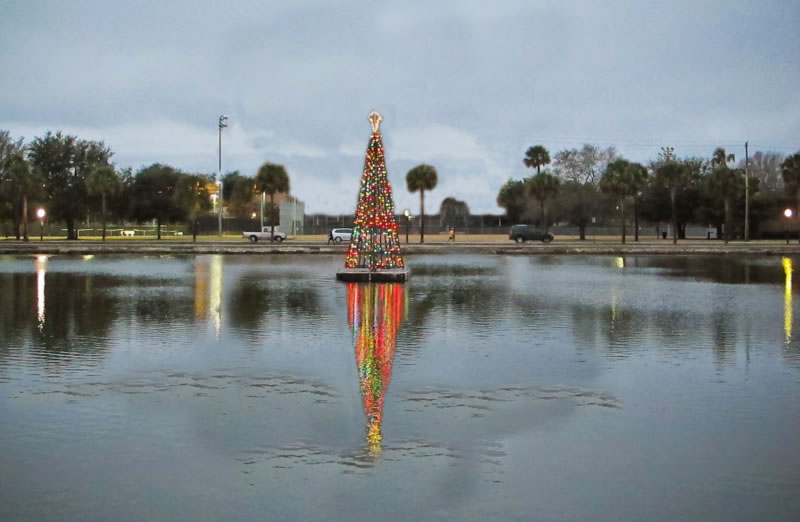
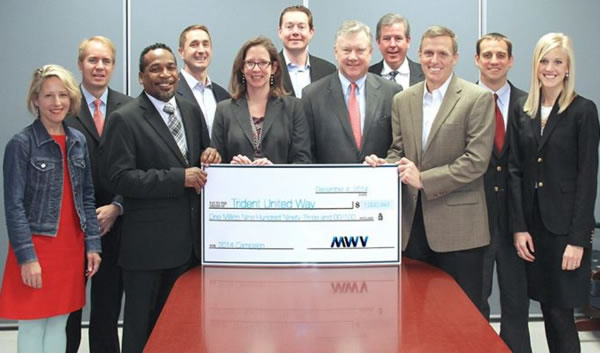
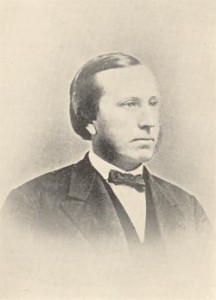

 We Can Do Better, South Carolina!
We Can Do Better, South Carolina!
























